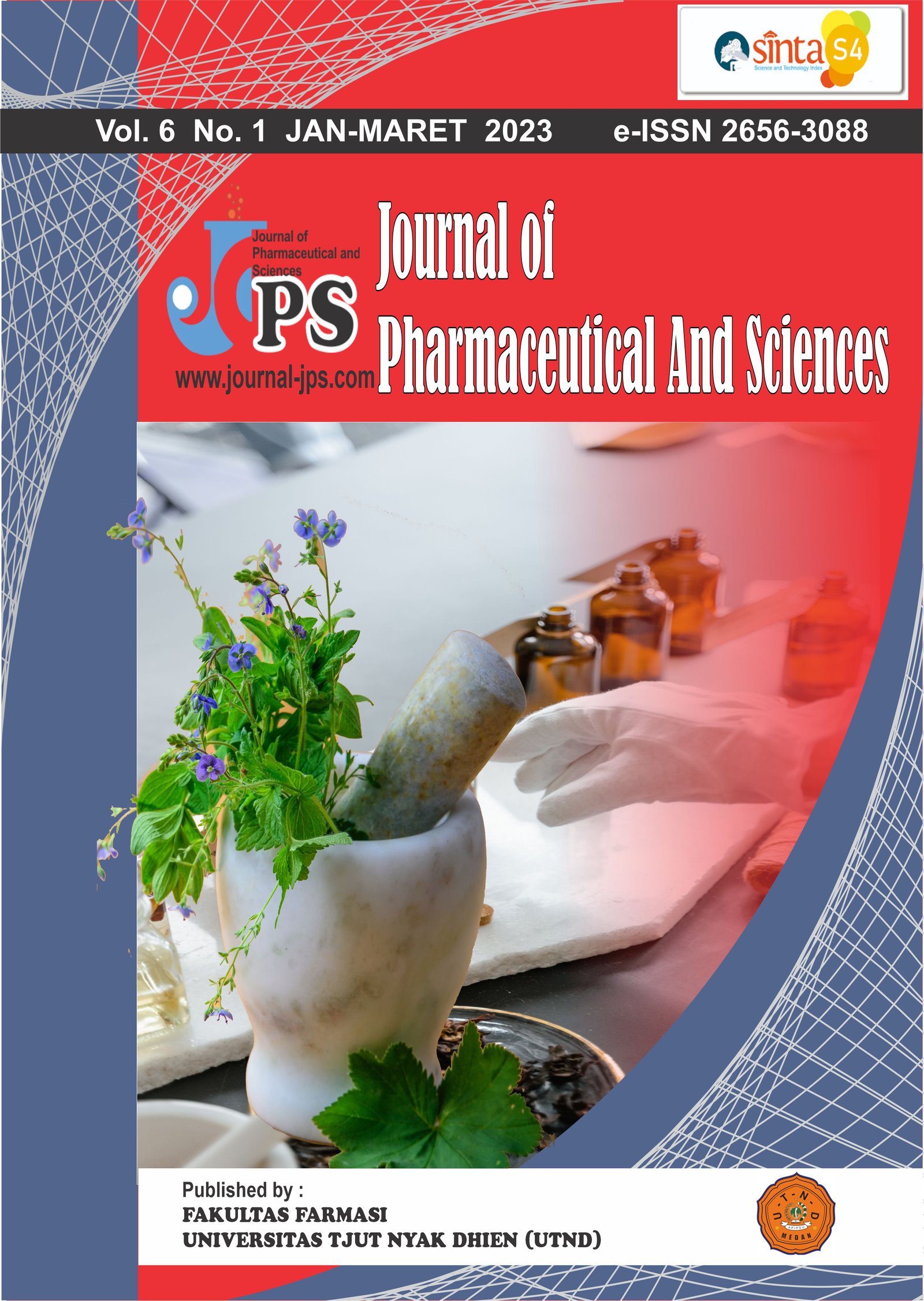ANALYSIS OF VARIOUS ISOFLAVONE IDENTIFICATION METHODS: LITERATURE REVIEW
Main Article Content
Page: 109-117
Abstract
Isoflavone is included in the phytoestrogens, a natural plant substance with a structure similar to 17-β-estradiol. It can bind to estrogen receptors so that isoflavones can prevent or slow down forms of cancer related to Alzheimer's hormones, osteoporosis, and others. Isoflavones are also included in the flavonoids found in fruits such as berries, grapes and are most abundant in soybeans and other nuts. From the literature study that has been conducted, it was found that there are several methods for identifying isoflavone compounds, including HPLC/HPLC, TLC, UV-Vis Spectrophotometry, Mass Spectrophotometry, and others. Of the many types of isoflavones that exist, the most commonly identified isoflavones are genistein and daidzein, which can be found in samples of soybeans, soy milk, and processed tempeh. The isoflavone content identified by each researcher differs in terms of the quantity and type of isoflavone content. This is because in identifying isoflavones, there are factors that influence them. The duration of fermentation has an effect because it is related to the presence of dissolved compounds during the fermentation process, which results in differences in the quantity of isoflavones, besides that the reactive and easily oxidized nature of isoflavones causes isoflavones to bind to other compounds to form new unknown compounds so that isoflavones are no longer identified.
Downloads
Article Details

This work is licensed under a Creative Commons Attribution-NonCommercial-ShareAlike 4.0 International License.
References
Bustamante-Rangel, M., Delgado-Zamarreño, M. M., Pérez-Martín, L., Rodríguez-Gonzalo, E., & Domínguez-Álvarez, J. (2018). Analysis of Isoflavones in Foods. Comprehensive Reviews in Food Science and Food Safety, 17(2), 391–411. https://doi.org/10.1111/1541-4337.12325
Crozier, A., Jaganath, I. B., & Clifford, M. N. (2009). Dietary phenolics: Chemistry, bioavailability and effects on health. Natural Product Reports, 26(8), 1001–1043. https://doi.org/10.1039/b802662a
Daud, A., Sulistyarti, H., Retnowati, R., & Ginting, E. (2019). High Performance liquid chromatography (hplc) method for determination of isoflavones content in shade-tolerant soybean dena i. IOP Conference Series: Materials Science and Engineering, 546(3). https://doi.org/10.1088/1757-899X/546/3/032004
Fawwaz, M., Natalisnawati, A., & Baits, M. (2017). Kadar Isoflavon Aglikon pada Ekstrak Susu Kedelai dan Tempe Determination of Isoflavon Aglicone in Extract of Soymilk and Tempeh. Industria: Jurnal Teknologi Dan Manajemen Agroindustri, 6(3), 152–158. https://doi.org/10.21776/ub.industria.2017.006.03.6
Foudah, A. I., & Abdel-Kader, M. S. (2017). Isoflavonoids. Flavonoids - From Biosynthesis to Human Health, 5. https://doi.org/10.5772/intechopen.68701
Hirjani, H., Mudasir, M., & Pranowo, H. D. (2018). Prediction of High Performance Liquid Chromatography Retention Time for Some Organic Compounds Based on Ab initio QSPR Study. Acta Chimica Asiana, 1(1), 24–29. https://doi.org/10.29303/aca.v1i1.6
Istiani, Y., Handajani, S., & Pangastusti, A. (2015). Karakterisasi senyawa bioaktif isoflavon dan uji aktivitas antioksidan dari ekstrak etanol tempe berbahan baku koro pedang (Canavalia ensiformis). Biofarmasi, 13(2), 50–58.
Jang, D., Jung, Y. S., Kim, M.-S., Oh, S. E., Nam, T. G., & Kim, D.-O. (2019). Developing and Validating a Method for Separating Flavonoid Isomers in Common Buckwheat Sprouts Using HPLC-PDA. Foods, 8(11), 549. https://doi.org/10.3390/foods8110549
Jiao, Z., Si, X., Zhang, Z., Li, G., & Cai, Z. (2012). Compositional study of different soybean (Glycine max L.) varieties by 1H NMR spectroscopy, chromatographic and spectrometric techniques. Food Chemistry, 135(1), 285–291. https://doi.org/10.1016/j.foodchem.2012.04.091
Li, B., Tian, L., Zhang, J., Huang, L., Han, F., Yan, S., Wang, L., Zheng, H., & Sun, J. (2014). Construction of a high-density genetic map based on large-scale markers developed by specific length amplified fragment sequencing (SLAF-seq) and its application to QTL analysis for isoflavone content in Glycine max. BMC Genomics, 15(1). https://doi.org/10.1186/1471-2164-15-1086
Miadoková, E. (2009). Isoflavonoids - an overview of their biological activities and potential health benefits. Interdisciplinary Toxicology, 2(4), 211–218. https://doi.org/10.2478/v10102-009-0021-3
Nemitz, M. C., Yatsu, F. K. J., Bidone, J., Koester, L. S., Bassani, V. L., Garcia, C. v., Mendez, A. S. L., von Poser, G. L., & Teixeira, H. F. (2015). A versatile, stability-indicating and high-throughput ultra-fast liquid chromatography method for the determination of isoflavone aglycones in soybeans, topical formulations, and permeation assays. Talanta, 134, 183–193. https://doi.org/10.1016/j.talanta.2014.10.062
Panche, A. N., Diwan, A. D., & Chandra, S. R. (2016). Flavonoids: an overview. Journal of Nutritional Science, 5, e47. https://doi.org/10.1017/jns.2016.41
Popa, D.-S., & Rusu, M. E. (2017). Isoflavones: Vegetable Sources, Biological Activity, and Analytical Methods for Their Assessment. In Superfood and Functional Food - The Development of Superfoods and Their Roles as Medicine. InTech. https://doi.org/10.5772/66531
Sartini, Djide, M. N., Permana, D., & Ismail. (2014). Ekstraksi Isoflavon Kedelai dan Penentuan Kadarnya Secara Ultra Fast Liquid Chromatography (UFLC) Soybean Isoflavones Extraction and Analysis Their Concentration by Ultra Fast Liquid Chromatography. Jurnal Sainsmat, 3(2), 130–134. http://ojs.unm.ac.id/index.php/sainsmat
Setiawati, A., Yuliani, S. H., Istyastono, E. P., Gani, M. R., Veronica, E. F., Putri, D. C. A., Putra, R. E., Putra, D. C., & Kurniawan, A. M. (2014). Analisis kuantitatif isoflavon tempe secara cepat dan sederhana menggunakan metode kromatografi lapis tipis-densitometri. JURNAL FARMASI SAINS DAN KOMUNITAS, 11(1), 13–17.
Sulistiani, H. R., Handayani, S., & Pangastuti, A. (2014). Karakterisasi senyawa bioaktif isoflavon dan uji aktivitas antioksidan dari ekstrak etanol tempe berbahan baku kedelai hitam (Glycine soja), koro hitam (Lablab purpureus), dan koro kratok (Phaseolus lunatus). Biofarmasi, 12(2), 62–72.
Sulistyowati, E., Martono, S., Riyanto, S., Lukitaningsih, E., Farmasi, S., Tinggi Ilmu Farmasi, S., Pharmasi Semarang, Y., & Letnan Jendral Sarwo Edie Wibowo Km, J. (2018). ANALISIS DAIDZEIN DAN GENISTEIN PADA KEDELAI (Glycine max L. Merril) VARIETAS ANJASMORO, ARGOMULYO DAN DENA 2 MENGGUNAKAN METODE KCKT. Media Farmasi Indonesia, 13(1), 1299–1304.
Szymczak, G., Wójciak-Kosior, M., Sowa, I., Zapała, K., Strzemski, M., & Kocjan, R. (2017). Evaluation of isoflavone content and antioxidant activity of selected soy taxa. Journal of Food Composition and Analysis, 57, 40–48. https://doi.org/10.1016/j.jfca.2016.12.015





